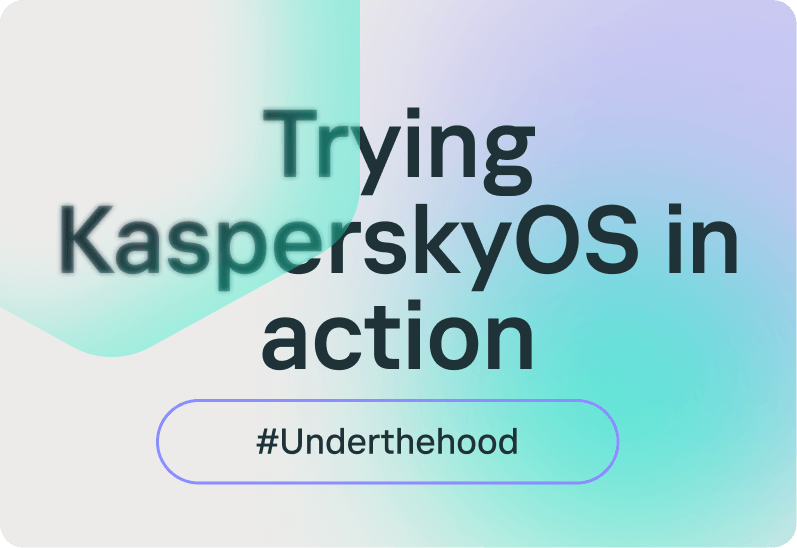
Kaspersky has developed its own microkernel operating system – KasperskyOS. KasperskyOS is designed to create software and hardware systems that are protected against any threats, even those that are unknown, and does not require additional protection such as antivirus. The KasperskyOS microkernel is written entirely from scratch and does not use Linux kernel code. A range of Cyber Immune IoT gateways, Cyber Immune thin clients, secure automotive gateways, and SDKs for IoT controllers have been developed based on KasperskyOS, and research is underway to apply KasperskyOS to professional mobile devices.
KasperskyOS can also be used in other areas by adapting it to various hardware platforms. Within the framework of a partnership, you can participate in the development of drivers, business applications, program modules, or build long-term business relationships by selling KasperskyOS-based products. For more information on commercial and technological partnerships, please contact us using the form at https://os.kaspersky.com/partners.
In other words, KasperskyOS is not currently an operating system for personal computers, so you won’t be able to use it as the main operating system on your PC or laptop. But you can try it for free. Here’s how.
To get acquainted with KasperskyOS and learn how to develop Cyber Immune solutions based on it, you don’t need to sign a partnership agreement. We have created a special publicly available version of the operating system – KasperskyOS Community Edition (CE). You can use it to master the basic principles of creating applications and security patterns.
There are three ways to try the KasperskyOS CE SDK.
1. You can run the KasperskyOS CE SDK with sample applications created for it on a regular desktop or laptop where Linux is installed, or on a virtual machine running Linux. You can install the SDK on Debian-like Linux distributions such as Ubuntu. Read more about compatibility here.
You can download KasperskyOS CE SDK here. The .deb package contains the OS kernel, a set of development tools, QEMU emulator and documentation. In effect, Linux acts as an environment in which an x86-based hardware platform is emulated using QEMU, and KasperskyOS is run in it.
The software package also includes code samples demonstrating the supported functionality: the use of GPIO, UART, USB drivers, MQTT protocol and others. Another set of examples demonstrates typical security patterns when developing on KasperskyOS: distrustful decomposition, kernel deferral, policy decision point and others.
2. It is possible to install the KasperskyOS CE SDK on a hardware platform – Raspberry Pi 4 model B minicomputer. You can find out how here.
3. Another option is to run the training samples on KasperskyOS using cloud services. We tested this feature for KasperskyOS CE SDK version 1.0.1. For the current version, KasperskyOS CE SDK 1.1.1, there may be deviations from these instructions. You can write about your experience and suggest improvements on our forum.
Download the KasperskyOS Community Edition distribution and start learning how to develop using the principles of Secure by Design.

Kaspersky has developed its own microkernel operating system – KasperskyOS. KasperskyOS is designed to create software and hardware systems that are protected against any threats, even those that are unknown, and does not require additional protection such as antivirus. The KasperskyOS microkernel is written entirely from scratch and does not use Linux kernel code. A range of Cyber Immune IoT gateways, Cyber Immune thin clients, secure automotive gateways, and SDKs for IoT controllers have been developed based on KasperskyOS, and research is underway to apply KasperskyOS to professional mobile devices.
KasperskyOS can also be used in other areas by adapting it to various hardware platforms. Within the framework of a partnership, you can participate in the development of drivers, business applications, program modules, or build long-term business relationships by selling KasperskyOS-based products. For more information on commercial and technological partnerships, please contact us using the form at https://os.kaspersky.com/partners.
In other words, KasperskyOS is not currently an operating system for personal computers, so you won’t be able to use it as the main operating system on your PC or laptop. But you can try it for free. Here’s how.
To get acquainted with KasperskyOS and learn how to develop Cyber Immune solutions based on it, you don’t need to sign a partnership agreement. We have created a special publicly available version of the operating system – KasperskyOS Community Edition (CE). You can use it to master the basic principles of creating applications and security patterns.
There are three ways to try the KasperskyOS CE SDK.
1. You can run the KasperskyOS CE SDK with sample applications created for it on a regular desktop or laptop where Linux is installed, or on a virtual machine running Linux. You can install the SDK on Debian-like Linux distributions such as Ubuntu. Read more about compatibility here.
You can download KasperskyOS CE SDK here. The .deb package contains the OS kernel, a set of development tools, QEMU emulator and documentation. In effect, Linux acts as an environment in which an x86-based hardware platform is emulated using QEMU, and KasperskyOS is run in it.
The software package also includes code samples demonstrating the supported functionality: the use of GPIO, UART, USB drivers, MQTT protocol and others. Another set of examples demonstrates typical security patterns when developing on KasperskyOS: distrustful decomposition, kernel deferral, policy decision point and others.
2. It is possible to install the KasperskyOS CE SDK on a hardware platform – Raspberry Pi 4 model B minicomputer. You can find out how here.
3. Another option is to run the training samples on KasperskyOS using cloud services. We tested this feature for KasperskyOS CE SDK version 1.0.1. For the current version, KasperskyOS CE SDK 1.1.1, there may be deviations from these instructions. You can write about your experience and suggest improvements on our forum.
Download the KasperskyOS Community Edition distribution and start learning how to develop using the principles of Secure by Design.